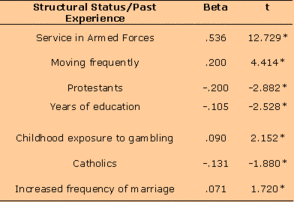The WAGER Vol. 7(11) – Sugar and Spice
Researchers have found the prevalence of problem gambling to be higher in men than women (Volberg, 1996). As past WAGERs have suggested, gender not only influences the prevalence of problem gambling, but also the developmental trajectory of problem gambling. This week’s WAGER reports on a study that investigated gender differences in predictors of problem gambling (Hraba & Lee, 1996).
Researchers used data previously collected by Hraba (1989) for the State of Iowa between April and June of 1989. Originally, 1226 Iowan households were contacted by phone, and a resident of each of 1,011 households completed the entire interview. The response rate was 82%1. Of the 1,011 participants, 45.4% were male, and 54.6% were female. Using this data, the authors explored several potential predictors of problem gambling including: economic factors, social characteristics, personality traits, and other variables such as age of exposure to gambling. Problem gambling was determined with a composite of 14 questions about gambling, the loss of control over gambling, and negative consequences of gambling. Some of the questions that comprised the composite were derived from the South Oaks Gambling Screen (SOGS) (Lesieur & Blume, 1987). The authors also explored gambling behavior differences between men and women. This WAGER focuses on findings related to possible Structural Status/Past Experience predictors of problem gambling behavior in men and women.
Researchers used a stepwise regression analysis to evaluate the predictive value of several variables. For male gamblers, the only significant predictor for problem gambling was education. Men with less education were more likely to have problems with gambling. However, several predictors for women gamblers emerged: level of education, armed forces service, religion, childhood exposure to gambling, number of marriages, and residential mobility. (See Table 1).
Table 1: Prediction of Problem Gambling In Women Using Structural/Past Experience Variables (2)
* p<.05
One limitation is the age of the data. The data used in this study was seven years old when Hraba and Lee analyzed it and social effects related to gender could be particularly sensitive to cultural climate. It is possible that these numbers do not reflect possible causes of problem gambling for women today. Also,this dataset might not generalize well outside of Iowa. Another problem is that conventional estimates of probable pathological or pathological levels of gambling are not known because standard problem gambling was determined with a composite of SOGS items and other items related to gambling. Consequently, the severity of the problems that are being predicted is unknown.
Despite these limitations, the study highlights the importance of examining potential predictors of gambling problems. This knowledge could inform the application of different treatment strategies for men and women who develop pathological levels of gambling. More investigation of these issues can help to clarify if different characteristics influence pathological gambling in women compared to men.
Notes
1. 49 households in addition to the 1226 were contacted, but interviews were not completed within study time parameters. With the 49 included in the total, the response rate is 79%.
2. Positive values indicate an increased likelihood of problem gambling. Negative values indicate a decreased likelihood of problem gambling.
References
Hraba, J. (1989). Report to Iowa Department of Human Services: Research on the Iowa Lottery and Gambling. Ames, Iowa: Department of Sociology, Iowa State University.
Hraba, J., & Lee, G. (1996). Gender, Gambling and Problem gambling. Journal of Gambling Studies, 12(1), 83-101.
Lesieur, H., & Blume, S. (1987). The South Oaks Gambling Screen (SOGS): A new instrument for the identification of pathological gamblers. American Journal of Psychiatry, 114, 1184-1188.
Volberg, R. A. (1996). Prevalence studies of problem gambling in the United States. Journal of Gambling Studies, 12(2), 111-128.
